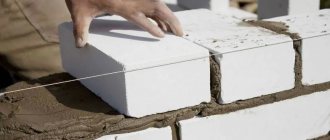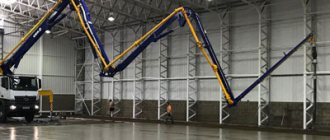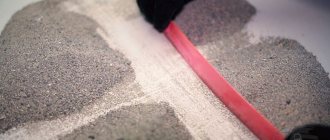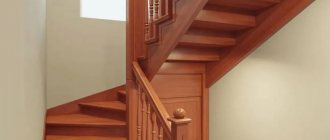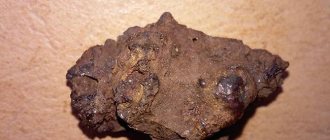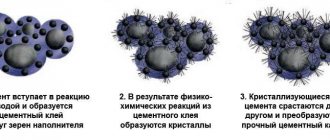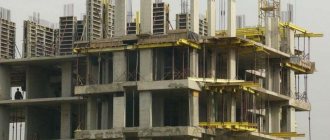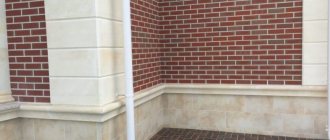Today, reinforced concrete structures are widely used in construction work; no modern construction can do without them. Any structures made of reinforced concrete are reliable, have high fire resistance, and have a long service life. They do not require special protection from destructive atmospheric influences. Over time, the strength of concrete only increases, and the reinforcement protected by it does not corrode at all. It is easy to build structures of various shapes from such material.
Construction using reinforced concrete structures is characterized by a high speed of work Source masterabetona.ru
Description
Reinforced concrete is a high-strength composite building material made from concrete and steel rods. This combination allows you to take advantage of the main advantages of both materials.
Concrete is considered an artificial stone. It perfectly withstands high compressive loads, but at the same time does not tolerate tension. The metal is characterized by low resistance to compression and significant resistance to tension. The combination of a steel frame and high-quality concrete allows reinforced concrete structures to withstand both tension and compression of the material.
Reinforcing metal rods inside reinforced concrete are connected by spot welding. The cross-sectional area of the rods is determined when calculating the loads. The method of connecting elements into a frame depends on the convenience of welding, laying the cement mixture, and other factors.
Reinforced concrete structures can withstand prolonged heating, so they are used for the construction of industrial facilities operated at high temperatures Source peymankarsa.ir
About delivery and intermediate storage of concrete products
It has already been mentioned that factory reinforced concrete products have a high degree of reliability and it depends only on the consumers themselves whether this reliability will decrease in the future. Products, before they get into the structure and take their intended place, may be subject to excessive mechanical loads or find themselves in conditions of high humidity. In addition, concrete is susceptible to biological corrosion (mold, mildew, etc.), which must be taken into account when storing it.
Damage to products can occur both during transportation (delivery) and during storage (interim storage). Moisture usually enters products through contact with the ground (capillary suction) or precipitation, which can lead to both deterioration of the mechanical characteristics of the product and the development of corrosive microflora on it.
The most common type of damage is mechanical. For example, when transporting floor slabs (placed, as they should be, on wooden spacers), concrete blocks were placed on top of them. As a result, the products arrived at the site deformed: with cracks more than 1 mm wide along the bottom, with concrete chips and exposed reinforcement. If this was due to the fault of the supplier, then such products must be replaced. But suppliers, as a rule, comply with the conditions of transportation and such situations practically do not arise.
But when the products arrive at the intermediate storage place, when money has already been paid for them and the products have been accepted by the customer, the owner must take care of the products that belong to him. Even if products are purchased for the purpose of using them for weeks or months, they must be provided with certain “comfortable” storage conditions. The area for storing them must be leveled; there should be no contact between the products and the ground; It is desirable to have a canopy or a film covering the product. It is advisable to store floor slabs horizontally (in the “working position”), laying them between each other with wooden blocks for ventilation and to relieve stress.
Advantages and disadvantages
Despite the fact that reinforced concrete is a fairly reliable building material, it has both advantages and disadvantages. The main advantages of reinforced concrete products are:
- Durability. With the correct load and proper operation, reinforced concrete structures last a long period of time. Moreover, their load-bearing capacity does not decrease at all.
- Relatively light weight. To achieve similar strength indicators, a monolithic material must weigh five times more.
- Fire resistance. Reinforced concrete elements do not support the combustion process.
- Self-sealing. Under the influence of moisture, the strength of the material increases.
- Corrosion resistance. The use of a special type of cement in the production of reinforced concrete products allows us to avoid corrosion processes.
- Manufacturability. You can produce elements of various shapes and give them any shade using additives.
- Affordable price. Monolithic and prefabricated reinforced concrete structures are characterized by minimal cost.
What not to do when installing reinforced concrete products
Any building product, including reinforced concrete products, is designed for certain loads, exceeding which is undesirable or unacceptable. For products subject to bending, building codes and regulations establish normative permissible loads. Let’s say right away that the magnitude of these loads provides a very, very significant margin of safety and, with correct installation of the structure, destruction of the product is practically excluded.
Each building structure (including floor slabs) is designed for specific installation schemes. These schemes are known to builders, and their violation can lead to undesirable consequences. Very often it becomes necessary to make a hole in a floor panel, and if during its formation the integrity of the panel’s reinforcement frame is damaged or, just as important, the reinforcing bars that provide the load-bearing capacity of this panel are cut, then the positive effect of “prestressing” will be almost completely eliminated. Such a damaged panel will not comply with the standard permissible load scale.
If you still need to make a hole in the panel, then it is necessary to provide a cantilever fastening of the cut panels to an intermediate support (for example, to an internal load-bearing wall or to a lintel) and to make a metal profile around the perimeter of the cut out part of the slab with fastening (threaded or welded) on this profile of the ends of the reinforcing bars.
Characteristics
The manufacturing process of a reinforced concrete structure consists of the following stages:
- Preparing the mold for pouring.
- Frame formation.
- Mixing cement mortar.
- Filling out the form.
- Waiting for the concrete to harden.
Among the most valuable properties of reinforced concrete for construction it is worth noting:
- high density;
- ability to withstand significant loads;
- resistance to moisture and temperature fluctuations.
Concrete and metal have similar expansion coefficients. Thanks to this, even under the influence of excessive temperatures, the integrity of reinforced concrete products is maintained.
Important! The density and moisture resistance of concrete prevent the development of corrosion of the metal that is enclosed in it. The hardened solution protects the iron from fire in the event of a fire at the location of the reinforced concrete structure.
How are concrete products made?
Floor slabs (hollow and ribbed), lintels, elements of fences, basements and foundations, road surface slabs, parts of wells and lighting poles are all products made of reinforced concrete. It is obvious that each product has a characteristic reinforcement system, concrete formulation and manufacturing technology.
Floor slabs and lintels that work in bending are made of prestressed reinforced concrete. Reinforcing bars are installed in the prepared mold on special stops, they are tensioned mechanically (using jacks) or thermomechanically (by heating with electric current) and secured in a tense position on the mold's side equipment.
Pouring the concrete mixture followed by vibration compaction can be carried out on stands (with the introduction of void formers) or on conveyor lines, including rolling or roller molding methods. After this, the products in the molds are sent for heat treatment in special chambers. The purpose of heat treatment is to accelerate the hardening of concrete, and after 8-12 hours of steaming at an ambient temperature of 80-95 C, the product gains 65-75% of its brand strength, equivalent to 28 days of hardening under natural conditions. After the product has hardened, the stressed reinforcing bars are released from their attachment to the walls of the mold. The rods are partially compressed along their length, and the stress from them is transferred to the concrete in the product - a stressed state is formed in the areas of concrete adjacent to the reinforcing bars.
Cylindrical products (racks, rings, etc.) are manufactured by centrifugation. First, reinforcing bars are placed in a half-mold placed on the centrifuge stand (they are tensioned if necessary), onto which metal wire is wound to form the frame of the product. Using a spoon concrete distributor, the concrete mixture is distributed along the entire length of the half-mold, one half-mold is covered on top of the other and the centrifuge is turned on. At the first stage, the concrete mixture, due to centrifugal forces, is distributed near the outer enclosing surface of a cylindrical shape. At the second stage, due to the changing rotation speed of the centrifuge, the concrete mixture is compacted and the product is formed. Next, the products (in half-forms or stripped) are sent for heat treatment.
Application area
Reinforced concrete products are widely used in modern construction in the construction of:
- residential buildings;
- industrial buildings;
- protective structures for various purposes;
- engineering structures.
A variety of high-strength reinforced concrete elements are used in the construction of foundations, walls, interfloor ceilings, and wells.
If we consider the narrowly targeted use of reinforced concrete, it is worth noting its demand in construction:
- bridges;
- hydroelectric power stations;
- airfields;
- structures in contact with water;
- nuclear reactors.
Important! To increase the resistance of reinforced concrete products to moisture, special substances are added to concrete during the process of their creation. They repel water and give the material anti-corrosion properties.
The external walls of buildings are assembled from expanded clay-reinforced concrete panels, the remaining elements are made from heavy concrete of various grades Source i.pinimg.com
What are concrete products made from?
Cement and water are the active components of concrete - as a result of the reaction between them, a cement stone is formed, which binds the aggregate grains into a single monolith. There is no chemical interaction between cement and aggregate, which is why aggregates are often called inert materials. However, coarse aggregate (crushed rock or limestone) and fine aggregate (quartz, also known as river sand) significantly affect the structure and properties of concrete.
Metal (steel) rods or bundles of wires are used as reinforcement. The fittings are divided into working and mounting. Working reinforcement is located in the lower part of products that work in bending: floor slabs, beams, in the soles of foundation blocks. Mounting reinforcement creates a three-dimensional skeleton of the product, fixes the location of the working reinforcement rods, and facilitates the fixation and fastening of embedded parts and mounting loops.
One type of reinforced concrete is prestressed reinforced concrete. Due to the use of special technological techniques, in the process of manufacturing materials from stressed reinforced concrete, the reinforcement is embedded in concrete in a partially stretched form.
The fact is that floor slabs and load-bearing beams in the structure work in bending. Firstly, they take the load of the floor structure (including its own weight); secondly, the load from household items placed on the floor; thirdly, the load transmitted from the walls to the building frame. As a result, the lower layers of the floor slab or load-bearing beam are slightly stretched, which negatively affects their reliability.
If the lower layers of the panel or beam were artificially compressed during the manufacturing process (“stressed” reinforced concrete), then under household and structural load they will be in a neutral state. In this case, the tension in them will be minimal, and, therefore, the problems associated with the operation of the structure will be minimal.
Types of reinforced concrete structures
There are three types of reinforced concrete. Each of them has its own positive and negative sides and is used when carrying out certain construction work.
Monolithic
Produced directly on the construction site. The simplest of them is the foundation. It is created in the following way: a pit is dug, a reinforcement frame is installed, which is then filled with liquid concrete. Subsequently, it hardens and turns into stone. The strength characteristics of the foundation depend on the quality of the reinforcement used and the grade of concrete.
The main advantages of the monolith are low material consumption, fire resistance, durability, strength, and ease of formation. Among the disadvantages, it is worth noting the likelihood of cracks forming on a monolithic foundation after shrinkage or excessive loads, high sound and thermal conductivity. Also, the disadvantages include the seasonality of the work. They are allowed to be carried out only during the warm period of the year.
Monolithic reinforced concrete structures are erected on the construction site: initially the formwork is installed, the frame is assembled, which are then filled with concrete Source ideal-prodakshn.od.ua
About defects, explicit and implicit
Sometimes the purchased batch includes products with obvious defects. Some of these defects are easily removable and cannot affect the quality of products, some are irreparable and are “lethal” in nature. Sometimes defects are of factory origin, sometimes they arise when products are picked up as a result of their incorrect transportation.
If the product is not externally damaged, but only small chips are present, then they can be easily eliminated by sealing them with cement-sand mortar or special repair mixtures. If the defect is serious (displacement of the reinforcement cage, incorrect anchoring of embedded parts and mounting loops, a thin protective layer of concrete), then such products must be returned to the manufacturer and subsequently replaced. But, as a rule, such defective products are identified at the acceptance stage by technical control, and if they leave the plant, then only as substandard.
Some manufacturing defects (for example, a network of superficial thin cracks on a floor slab) are not “lethal” in nature and do not affect the reliability and load-bearing capacity of the product. Such defects are eliminated during the installation of products.
Types of reinforced concrete and production features
Reinforced concrete or otherwise reinforced (structural) concrete, in accordance with the manufacturing technology of the steel frame, is divided into non-prestressed (ordinary) and prestressed. The difference between them is that in the second case, the reinforcing mesh is fixed with pre-tension, as a result of which the metal rods, after the concrete hardens and the tensioners are removed, work under compression, transmitting it to the entire structure. The difference lies in the components used:
| Type of reinforcement | Concrete class | Reinforcement diameter | Reinforcement class |
| Unprestressed | B15 | from 4 mm | A240 – A500, B500 |
| Prestressed | from B20 to B80 | from 10 mm | А540 – А1000, Вр1300 – Вр1500 |
In addition to the difference in the organization of the reinforcing frame, reinforced concrete differs in the peculiarities of the production process, according to which monolithic structures and prefabricated structures are distinguished.
Monolithic reinforced concrete
Monolithic reinforced concrete includes structures manufactured directly at the installation site in the position and shape specified by the project. One of the striking examples of this type of reinforced concrete structure is the foundation. The construction of monolithic reinforced concrete structures is carried out in compliance with the following stages:
- creating a form (formwork) by installing and strengthening scaffolding from boards;
- preparation of steel reinforcement;
- formation of a reinforcing frame;
- preparing the concrete mixture and pouring it into the formwork;
- caring for the concrete structure during its hardening period while maintaining optimal humidity and temperature conditions;
- releasing an already hardened concrete structure from its mold.
A large list of operations and the need to maintain their sequence lead to a reduction in the pace of construction work. Therefore, prefabricated reinforced concrete is most often preferred for construction.
Reinforced concrete – myth or reality?
You can often see sellers on the Internet who offer 100% outcome of a sporting event. And beginners, for the most part, dream of purchasing a forecast that will bring huge winnings without risk, but let’s take a closer look at this phenomenon.
The world of sports is very diverse and competitive. Now, for example, there is simply fabulous money circulating in football and other sports. And matches are composed in most cases in such a way as to maintain competitiveness and interest. A reinforced concrete bet in this case can only include a fixed match . True, various committees and commissions in sports are struggling with violations and fraud.
Let's imagine a situation in which a certain person obtained insider information in a purchased match.
Ask yourself a question: why would such a person share hidden and invaluable information for the sake of a small reward?
Such insider information simply does not leak out to the masses and it costs incredible amounts of money. In addition, if many bettors find out about this information, then when betting they will lose the odds, the bookmakers will sense something is wrong and remove the match from the line. The above is proof of the complete lack of sense in selling insider information.
So, we figured out that a 100% chance of passing is a myth or an extremely rare phenomenon that is not available to the average fan. Now let's talk about strong bets with a probability of 90%. And yes, such bets do happen, but they are not win-win, but only carry minimal risk. The odds for such outcomes are very small, since analytical centers in bookmakers always work very competently. Here the spread of odds is from 1.01 to 1.2.
On topic: Analysis of the growth in traffic to online bookmakers in Russia in the spring of 2022

